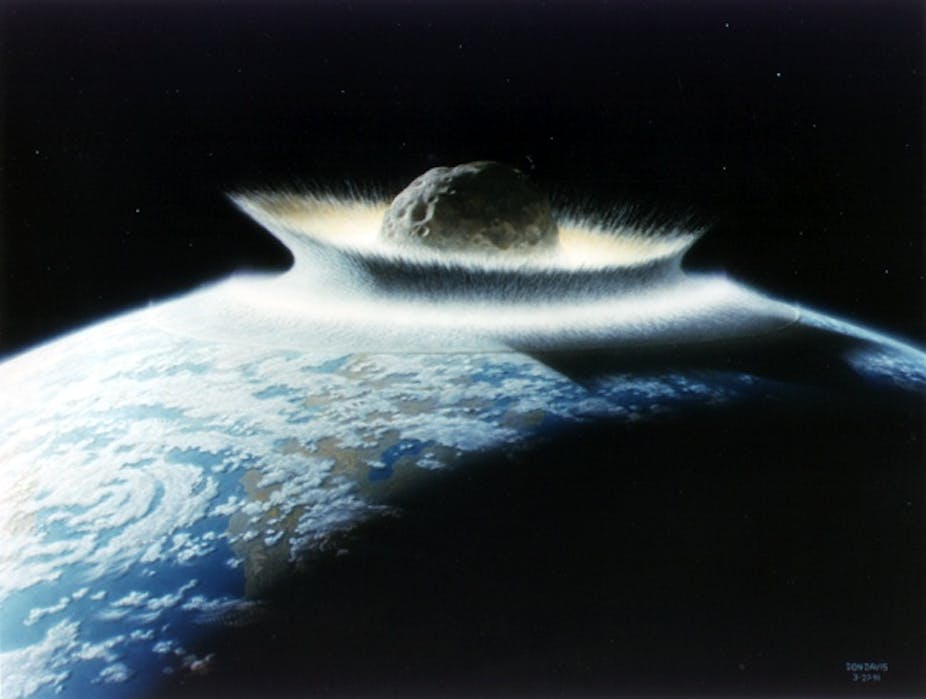How many times have you read a headline about our impending doom due to a “Deep Impact”-style annihilation?
In a way it’s not surprising – we have an insatiable appetite for disaster stories, a hunger Hollywood is all too keen to feed. And, in many ways, an asteroid impact is the ultimate catastrophe.
But today the not-for-profit B612 Foundation will unveil plans to build the Sentinel Space Telescope – the world’s first privately funded space telescope, designed to map the solar system for potentially dangerous asteroids.
One asteroid that received significant media interest was Apophis, a 270-metre-wide near-Earth object that, in late 2004, was given a 1-in-37 chance of hitting Earth in 2029.
Further observations almost certainly ruled that impact out, but indicated a possible collision on April 13, 2036 (an exact date, no less). The chances of an impact are now rated as 1 in 250,000 and falling. Despite what you might read on the internet, we don’t need to worry about Apophis.
But how seriously should we take the threat of an asteroid impact more generally? Very seriously – after all, the impact of a 10-kilometre-wide asteroid at Chicxulub in Mexico is thought to have wiped out the dinosaurs.
And here’s another reason to worry: there are still plenty of “Potentially Hazardous Asteroids”, as NASA calls them, that we haven’t even found yet.
Following research using the NASA Wide-field Infrared Survey Explorer, researchers announced in May that we now know of around 96% of the potentially dangerous asteroids greater than 1km in diameter, but less than 30% of the objects between 100 metres and 1km.
That leaves at least 70% of the objects that could wreak serious havoc on the earth’s surface still unaccounted for. For the more macabre readers, there is even a website that will let you determine the impact of an event. Scary stuff.
Last year in November, an object romantically named 2005 YU55 passed within about 320,000km of Earth. The object is about 300m in diameter, and NASA estimates it would have created a 6.5km-wide crater and a magnitude-7.0 earthquake had it struck land, or a 20-metre-high tsunami had it landed in the ocean.
Not quite an “Extinction Level Event”, but still enough to cause major problems if it had landed in or near a heavily populated area. We had only known about this object for about six years when it swung by last year.
More recently – just two weeks ago in fact – the near-Earth object 2012 LZ1 passed within 5.3 million kilometres of Earth. It was discovered on June 10 at Siding Spring Observatory by astronomer Rob McNaught and was determined to be about 500m in diameter.
That’s not quite the size you’d need before calling in Bruce Willis (see video below), but it’s not far off. Somewhat alarmingly, the object’s closest approach was only four days after it was discovered.
Subsequent radar observations using the 300m radio dish at Arecibo in Puerto Rico revised the object’s size upward to about 1km. Now we’re talking about one of the 4% of previously unknown asteroids that could decimate large swathes of the earth. Worse still, had it been on a collision course, we would have only had four days notice.
The problem seems to be that 2012 LZ1 only reflects 2-4% of the light landing upon it, making it darker than charcoal. Astronomers normally assume an asteroid reflects around 10% of the sun’s rays off its surface.
What impact does this have on the number of big asteroids we’re missing? It’s difficult to say, but my guess is the number goes up.
Bear in mind though that no asteroid has been positively identified as posing a probable threat to Earth. Catastrophic events are very rare: kilometre-size asteroids (which pose a global rather than local threat) impact the earth’s surface every million years or so. We don’t need to panic, but we should be prepared.
So what should we – or can we – do about it? Well, NASA runs the Near Earth Object Program, which helps to coordinate efforts to find and study the asteroids. There are also many amateur astronomers who dedicate their time to following up discoveries from their own backyards. These searches are often collectively known as the Spaceguard Survey.
And since 2002 the aforementioned B612 Foundation has been looking into ways of avoiding a “Deep Impact”-style event. More specifically, they are looking at ways to deflect asteroids away from a collision course with Earth.
The plan isn’t to use the standard Hollywood method – nuclear weapons – but rather to attach plasma engines to the asteroids surfaces to gently steer them to a new trajectory. A velocity change of only 1-2 centimetres per second (cm/s) should be enough.
The B612 Foundation’s soon-to-be-announced Sentinel Space Telescope will hopefully shore up our defences against asteroids, mapping out the current and future locations and trajectories of all asteroids that may pose a threat to Earth.
With greater notice, we may just be able to avoid disaster in the event something is found heading in our direction.
Of course, failing that, we still have Bruce Willis – for now.

